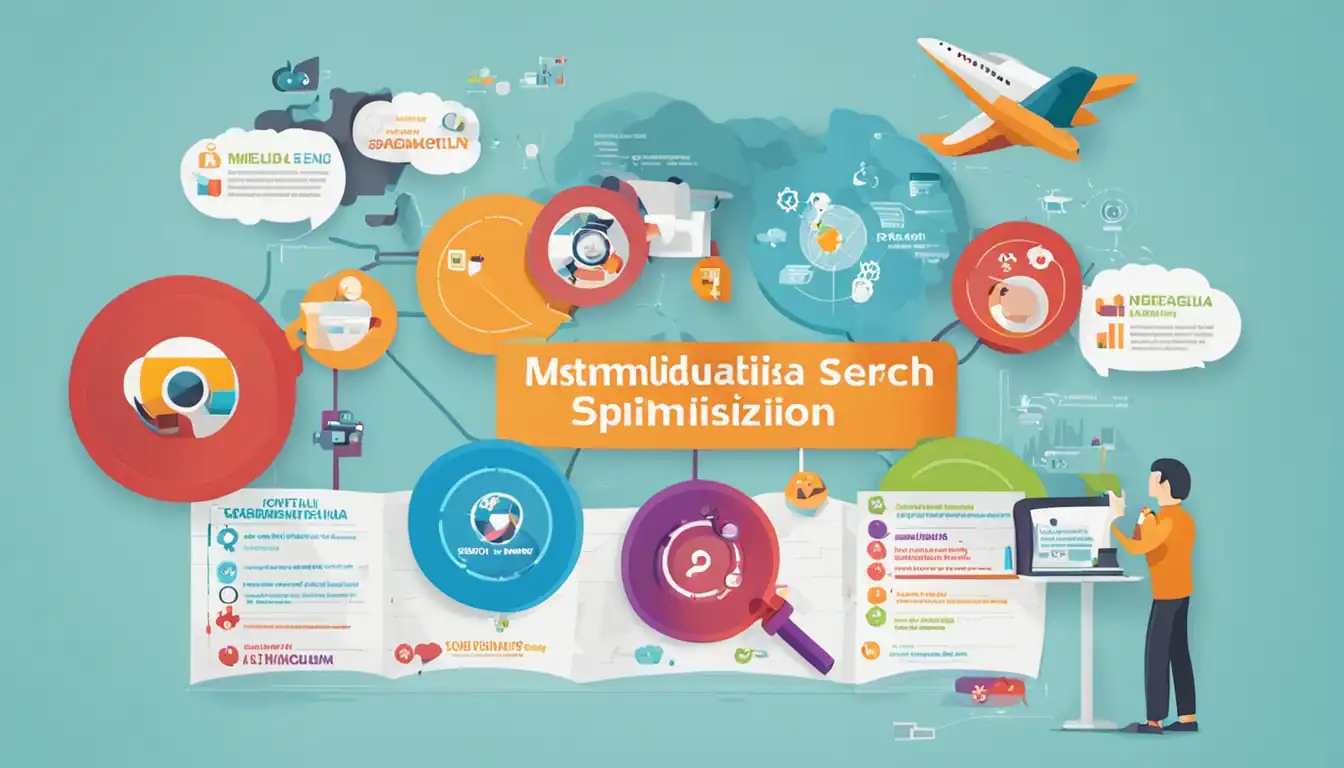Effective Content Strategies for SEO

In the vast and ever-changing landscape of digital marketing, mastering the art of SEO is essential for driving organic traffic to your website. But what good is SEO without effective content strategies to back it up? In this post, we'll delve into the world of content-driven SEO and explore how you can create compelling, high-ranking content that not only attracts visitors but also converts them into loyal customers.
Understanding SEO and Its Impact on Content Creation

Search Engine Optimization (SEO) is the practice of optimizing your website to increase its visibility in search engine results pages. By understanding how SEO works, you can create content that ranks higher and drives more organic traffic to your site.
The Basics of SEO
- Keywords: Research and use relevant keywords that your target audience is searching for.
- On-page optimization: Optimize title tags, meta descriptions, headings, and content for keywords.
- Off-page optimization: Build backlinks from reputable websites to improve your site's authority.
- Technical SEO: Ensure your website is easily crawlable by search engines and has fast loading times.
How SEO Influences Content Strategy
SEO plays a crucial role in shaping your content strategy. By aligning your content with SEO best practices, you can improve your chances of ranking higher in search results and attracting more visitors to your site.
"Effective content strategies for SEO involve creating high-quality, valuable content that is optimized for search engines."
When creating content for SEO, consider the following strategies:
- Keyword research: Identify relevant keywords with high search volume and low competition.
- Content optimization: Incorporate keywords naturally throughout your content while maintaining readability.
- Quality over quantity: Focus on creating valuable, engaging content that resonates with your audience.
- Regular updates: Keep your content fresh and up-to-date to maintain relevance in search results.
Incorporating these strategies into your content creation process will help you achieve better results in terms of SEO performance and overall online visibility.
Crafting Your SEO Content Plan
Crafting an effective content strategy is essential for improving your website's search engine optimization (SEO) performance. By following these key steps, you can create high-quality content that drives traffic and boosts your online visibility.
Setting Clear Objectives
Before diving into creating content, it's crucial to establish clear objectives for your SEO efforts. Define what you want to achieve with your content, whether it's increasing organic traffic, generating leads, or improving brand awareness. Setting specific and measurable goals will help guide your content creation process and track the success of your SEO strategy.
Audience Analysis and Keyword Research
Understanding your target audience is vital for creating content that resonates with them. Conduct thorough audience analysis to identify their needs, preferences, and pain points. This information will help you tailor your content to address their interests and provide valuable solutions.
Keyword research is another critical aspect of SEO content planning. Identify relevant keywords that align with your audience's search intent and incorporate them strategically into your content. Use tools like Google Keyword Planner or SEMrush to discover high-performing keywords in your industry.
By setting clear objectives and conducting thorough audience analysis and keyword research, you can develop a solid foundation for crafting effective SEO content that drives results.
Key Components of High-Ranking Content
When it comes to creating content that ranks well in search engine results, there are several key components that play a crucial role. Understanding these components and incorporating them into your content strategy can help boost your SEO efforts and drive more organic traffic to your website.
Quality Over Quantity: A Closer Look
In the world of SEO, quality always trumps quantity. While it may be tempting to churn out as much content as possible in the hopes of ranking higher in search results, this approach is not sustainable in the long run. Search engines like Google prioritize high-quality content that provides value to users over thin, low-quality content that is only created for the purpose of ranking.
To ensure that your content is of high quality, focus on creating well-researched, informative, and engaging pieces that address the needs and interests of your target audience. This will not only help you rank higher in search results but also establish your website as a reliable source of information within your industry.
The Role of Originality and Relevance
Originality and relevance are two other important factors to consider when developing content for SEO purposes. Search engines value original content that offers a unique perspective or insight on a particular topic. Avoid duplicating content from other sources or using generic templates that offer little value to readers.
Additionally, ensure that your content is relevant to your target audience and aligns with their interests and needs. Conduct keyword research to identify popular search terms related to your industry or niche, and incorporate these keywords naturally throughout your content to improve its visibility in search results.
By focusing on quality over quantity, originality, and relevance in your content strategy, you can create high-ranking content that resonates with both search engines and users alike.
On-Page Optimization Techniques
Strategic Keyword Placement
Incorporating relevant keywords strategically throughout your content is crucial for SEO success. Conduct thorough keyword research to identify the terms and phrases your target audience is searching for. Once you have a list of keywords, integrate them naturally into your content, including in titles, headings, meta descriptions, and body copy. Avoid keyword stuffing, as this can harm your rankings.
Enhancing Readability and User Engagement
Creating high-quality content that is easy to read and engaging for users is essential for SEO. Use clear headings and subheadings to break up text, making it easier for readers to scan the content. Incorporate multimedia elements such as images, videos, and infographics to enhance user engagement. Additionally, make use of bullet points and numbered lists to present information in a digestible format.
"Readability plays a significant role in keeping users on your site longer and reducing bounce rates. Focus on creating content that is both informative and easy to consume."
Off-Page Elements That Boost Content Effectiveness
Building Authority Through Backlinks
One of the most crucial off-page elements for boosting content effectiveness in SEO is building authority through backlinks. Backlinks are links from other websites that point to your content, signaling to search engines that your content is valuable and trustworthy. The more high-quality backlinks you have, the higher your content will rank in search engine results pages.
To effectively build authority through backlinks, focus on creating high-quality, valuable content that other websites will want to link to. Reach out to relevant websites in your industry and ask them to link to your content. Additionally, guest posting on reputable websites can help you earn backlinks and establish yourself as an authority in your field.
Social Signals and Their Influence on SEO
In addition to backlinks, social signals also play a significant role in boosting content effectiveness for SEO. Social signals refer to the engagement metrics on social media platforms such as likes, shares, comments, and retweets. When your content receives a high level of engagement on social media, it sends positive signals to search engines about the quality and relevance of your content.
To leverage social signals for SEO success, create shareable content that resonates with your target audience. Encourage social sharing by including social sharing buttons on your website and actively promoting your content on social media channels. Engage with your followers and encourage them to interact with your posts, increasing the likelihood of generating valuable social signals for improved SEO performance.
Leveraging Multimedia for Enhanced SEO

The Power of Images and Videos in SEO
Incorporating high-quality images and videos into your content can significantly boost your SEO efforts. Visual content not only enhances the user experience but also helps improve engagement metrics, such as time on page and bounce rate. Search engines like Google also prioritize websites that feature multimedia content, making it essential for a successful SEO strategy.
Infographics and Visual Data Integration
Infographics are an excellent way to present complex information in a visually appealing format. They are highly shareable and can attract backlinks from other websites, further enhancing your site's authority. Additionally, incorporating visual data such as charts and graphs can make your content more informative and engaging for readers. By leveraging infographics and visual data, you can effectively communicate your message while improving your SEO performance.
Advanced Tactics for Competitive Edge
In the ever-evolving landscape of SEO, staying ahead of the curve is essential to maintaining a competitive edge. Here are some advanced tactics that can help elevate your content strategy:
Topic Clusters and Content Silos
One effective strategy for boosting SEO rankings is to organize your content into topic clusters and content silos. This involves grouping related content together around a central pillar page, with each supporting piece linking back to the pillar. By creating this interconnected web of content, search engines are better able to understand the relevance and authority of your site on a particular topic.
Key Points:
- Organize content into clusters around a central pillar page
- Link supporting pieces back to the pillar for increased visibility
- Improve site authority and relevance on specific topics
Mobile Optimization and Voice Search Considerations
As mobile usage continues to rise, optimizing your content for mobile devices is crucial for SEO success. Ensure that your website is responsive and loads quickly on mobile devices to provide a seamless user experience. Additionally, with the growing popularity of voice search, it's important to tailor your content to match conversational queries. Focus on long-tail keywords and natural language phrases that align with how users speak when using voice search.
Key Points:
- Optimize website for mobile responsiveness
- Prioritize fast loading times on mobile devices
- Tailor content for voice search with conversational keywords
By implementing these advanced tactics in your content strategy, you can gain a competitive edge in the world of SEO and drive more organic traffic to your website.
Measuring Success in Your SEO Efforts

In order to determine the effectiveness of your content strategies for SEO, it is crucial to measure the success of your efforts. By tracking key performance indicators and utilizing tools for tracking and analysis, you can gain valuable insights into how well your content is performing and make informed decisions on how to optimize it further.
Key Performance Indicators to Watch
When monitoring the success of your SEO content strategies, there are several key performance indicators (KPIs) that you should pay close attention to:
Organic Traffic: This metric measures the number of visitors coming to your website through organic search results. An increase in organic traffic indicates that your content is ranking well and attracting more visitors.
Keyword Rankings: Monitoring the rankings of your target keywords can give you an indication of how well your content is optimized for search engines. Improvements in keyword rankings show that your content is relevant and valuable to users.
Click-Through Rate (CTR): CTR measures the percentage of users who click on your website's link after seeing it in search results. A high CTR indicates that your content is compelling and relevant to users' search queries.
Bounce Rate: Bounce rate shows the percentage of visitors who leave your website after viewing only one page. A high bounce rate may indicate that your content is not meeting users' expectations or needs.
Conversion Rate: Conversion rate measures the percentage of visitors who take a desired action on your website, such as making a purchase or filling out a form. A high conversion rate indicates that your content is effectively driving user engagement.
Tools for Tracking and Analysis
To effectively track and analyze the performance of your SEO content strategies, consider using the following tools:
Google Analytics: Google Analytics provides valuable insights into website traffic, user behavior, and conversions. It allows you to track key metrics mentioned above and gain a deeper understanding of how users interact with your content.
Google Search Console: Google Search Console helps you monitor how Google views and indexes your website's pages. It provides data on keyword rankings, click-through rates, and other important metrics related to search visibility.
SEMrush: SEMrush is a comprehensive SEO tool that offers features such as keyword research, competitor analysis, backlink auditing, and more. It can help you identify opportunities for improving your content strategy based on data-driven insights.
By regularly monitoring these key performance indicators and utilizing tools for tracking and analysis, you can assess the effectiveness of your content strategies for SEO and make informed decisions on how to optimize them further for better results.
Conclusion
In conclusion, implementing effective content strategies for SEO is a crucial step in maximizing your online visibility and reaching your target audience. By understanding the basics of SEO, crafting a solid content plan, optimizing on-page elements, leveraging off-page tactics, incorporating multimedia, and utilizing advanced techniques, you can set yourself apart from the competition and achieve sustainable success in the digital realm. Remember to measure your efforts using key performance indicators and tracking tools to continuously refine and improve your content strategy for long-term results.